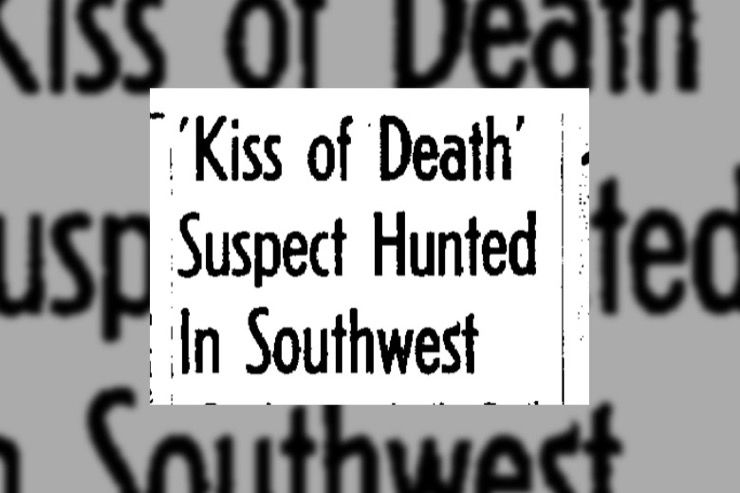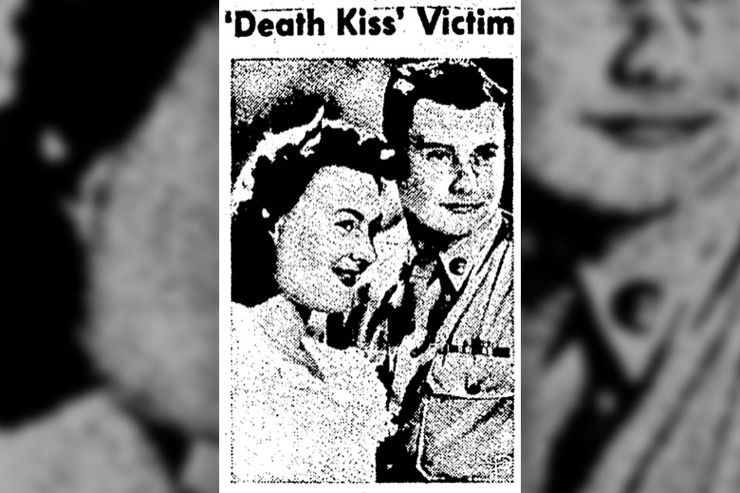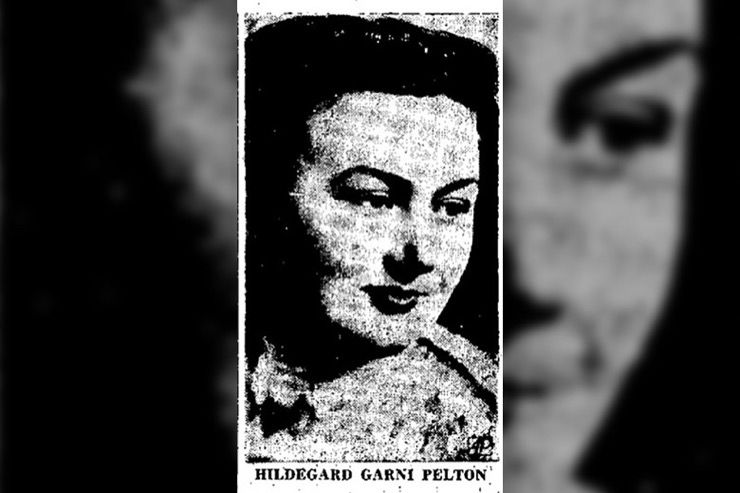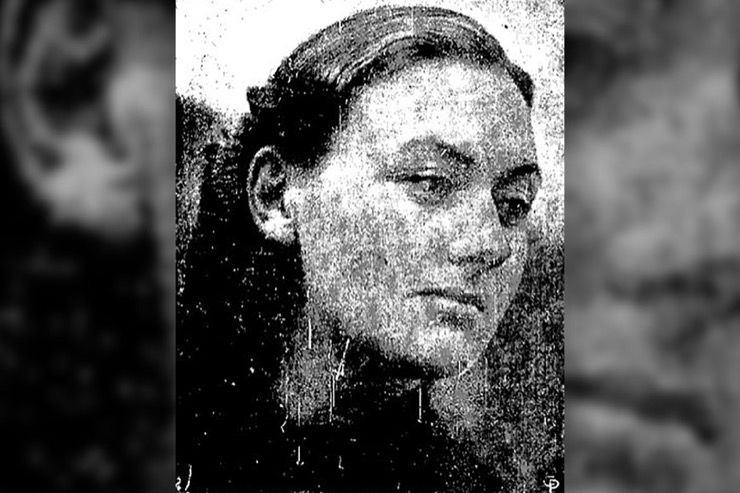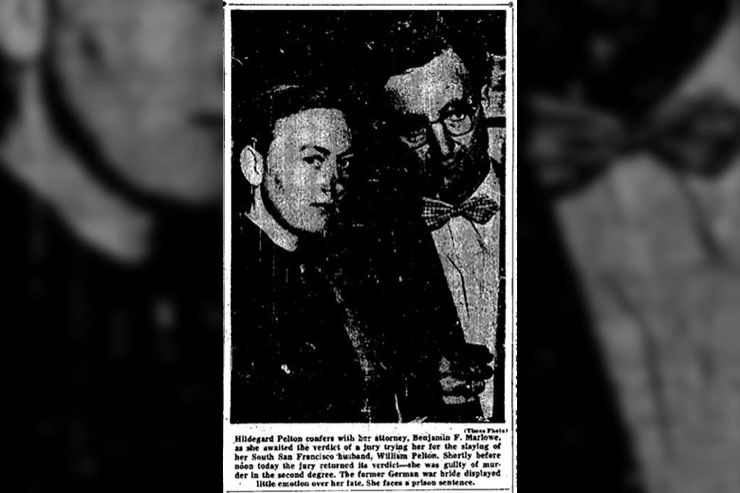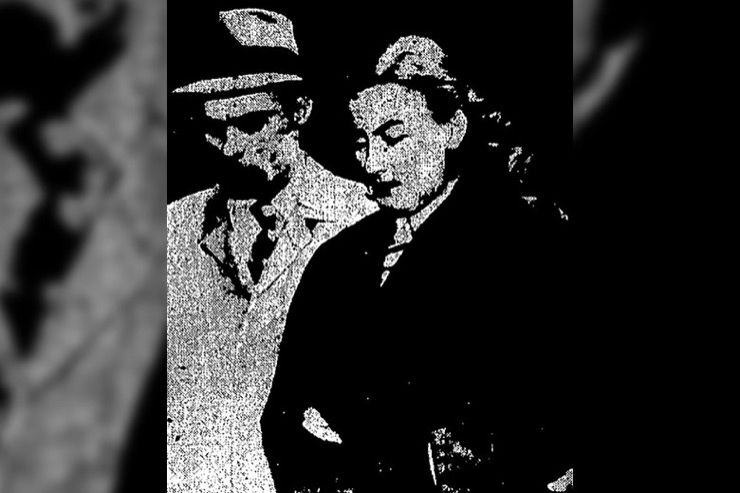Back in 1953, in the early days of President Dwight D. Eisenhower’s tenure, Salem was a bustling town full of reporters due to the recent opening of several factories there. But a grizzly murder would put this otherwise small and unassuming town firmly in the nation’s spotlight.
When World War II vet William T. Pelton was found propped up against his sports car riddled with at least nine bullets on a back road outside Niles, California, even more reporters rushed to the town to report on the unfolding story live.
Last Kiss
Among the nine bullet wounds, cops found the most curious thing. A perfect red lipstick kiss, which had been planted squarely on the victim’s forehead sometime after he was killed, puzzled detectives who hadn’t assumed that a woman was involved in the brutal murder of this man. The killer had even wiped the victim’s brow clean before planting that ‘kiss of death.’
International Spectacle
The murder was so gruesome and strange that it garnered serious international attention. The tiny town of Salem was suddenly full of reporters and news stories about the murder which had been dubbed the “Kiss of Death Murder.” But who would want to kill this brave World War II veteran? And why would they do it so brutally in cold blood?
Humble Roots
William “Bill” Pelton was born in 1926 and raised in Dent County. Having worked as a teenager at Vessie Wisdom’s service station, Pelton was one of 44 proud graduates from Salem High School’s Class of 1944. World War II was afoot, and Pelton joined 10 of his classmates enlisting in the military once diplomas were received. One of Pelton’s friends who went to war with him was Ted Ziske.
Average Man
Ziske said, according to a Salem News report: “The Bill Pelton I knew was honest and always on time for work,” he said. “He was also absolutely an average young man. In appearance, intelligence and physique – he was average – and he never got in any trouble. I remember we were on an intramural basketball team together at one time, but again, we were very mediocre.” Then Pelton was assigned to the 143rd Ordinance Battalion of the US Army during the war, rising in rank to staff sergeant.
Older Woman
It was 1945 and Pelton was stationed in Munich after the Americans occupied Germany. There, he fell in love with a Bavarian woman six years his senior, but the age difference didn’t bother Pelton in the slightest. Not much is known about Hildegarde Garni, apart from the fact she was stunning and had amazing strawberry-blonde hair.
American Bar
According to another of Pelton’s classmates, Charles Grosse, he had seen Garni at an American bar in Munich on more than one occasion. “There was an American bar in Munich which was really popular after the war, and I remember seeing her (Hildegarde) there often,” Grosse explained. “She was very pretty and outgoing. We actually sat next to each other once at the bar when she was on a date there with another man.”
Coming Home
It was the summer of 1947 when Garni agreed to marry Pelton and take his name. She arrived in Dent County and stayed at her in-laws as she awaited the arrival of her new husband who was stationed in New Jersey. He was due home any minute and Garni couldn’t wait to start her new life with her new husband in America. Grosse lived just down the street and remembers bumping into Garni one day.
American Wives
“I lived just down the road from the Peltons on Washington Street, and I remember bumping into her (Hildegarde) right in front of Vernon Butler’s house,” Grosse explained. “We both recognized each other and were surprised to meet again in Salem. I asked what in the world she was doing here, and she said she’d just married Billy Pelton. I can’t say I was too surprised; there were a lot of women in Europe at the time who wanted to come to the USA as wives.”
New Job
Following the war, Pelton and his wife decided to move to California in 1949 to seek work and a new life. By the year 1953, Pelton was employed as an airline mechanic and was doing well financially. His brand new convertible sports car was a testimony to all his hard work, and he loved his car passionately. Pelton and his wife were living the proverbial American dream by all standards.
Splitting Up
While everything was going well financially speaking, all was not well in the marriage between Pelton and Garni. In 1953, Pelton had obtained an interlocutory decree of divorce by default from Hildegarde without her knowledge. Even though the couple had split up on at least three occasions prior, the official documents came as a shock to Garni who was staying in Flagstaff, Arizona at the time.
Wanting Answers
While Garni knew her marriage was on the rocks, she wasn’t expecting her husband to go ahead and divorce her. Infuriated by the situation, Garni returned to San Francisco to confront her husband, but she made a purchase before she did so. Quite why she bought that Harrington and Richardson .22-caliber revolver no one knew at the time. But it would become clear as day soon enough.
Final Destination
Pelton thought nothing of the scenic ride he took with his wife on February 2, 1953. The couple drove around chatting and then ended up on a deserted road just outside of Niles in Alameda County. No one knows what was said that night but before long Garni had shot her husband nine times in the face, neck, and head. She then draped his dead body in a red hook rug and propped him up against his beloved sports car.
To Mexico
The gruesome murder got its nickname after Garni wiped the sweat and blood from her dead husband’s forehead and kissed it, leaving a bold red lipstick mark on him. She then wandered over to a nearby highway and hitchhiked a lift down to Mexico where she felt she would be safe from law enforcement. But what prompted this woman to kill her husband and in such a brutal way?
Weapon Found
As well as finding several bags packed with woman’s clothing in the sports car, detectives also found the weapon used in the murder. It was found a short distance away wrapped in a multicolored scarf and perforated with bullet holes. It didn’t take long for law enforcement to connect the murder with Garni but she was nowhere to be seen, and the cops had no idea that she had fled to Mexico.
Front Page News
On February 7, 1953, the shocking story made front page news on the cover of the Salem Newspaper. “Extreme interest in the sensational killing was shown by California newspapers,” The Salem News reported. “A long-distance call was received by The Salem News from a California newspaper in search of details of the background of the murder victim. Other calls were received in Salem from California in connection to the case,” it read.
Total Shock
As well as being shocked, Ziske and Grosse said it was totally out of character for Pelton to be involved in any form of violence as he was such a calm and softly spoken man. “I was pretty shocked. It was very unusual and unexpected,” Ziske says. “The incongruity that Bill Pelton could be involved in such a thing. He was absolutely the last person you’d expect to be murdered in such a way.”
Not Cruel
Pelton’s friend Grosse was also shocked by the murder of his friend. “Billy Pelton was not dominating or cruel in any way, and I can’t imagine him being unfaithful,” Grosse said. “I kept trying to explain to myself how such a thing could happen. I wouldn’t have dreamed in my wildest dreams that this boy, who I used to walk to school with, would end up shot so many times in a convertible in California.”
The War Bride
While Pelton’s body was returned to Salem for burial at the Spencer Funeral Home, Garni was dubbed “The War Bride” by the media, even if there was no sign of her. Having received full honors, Pelton was interred at the Cedar Grove Cemetary on February 4, 1953 – but where was Garni? Surely she wouldn’t be staying in Mexico for too long.
Where’s Garni?
Soon after arriving in Mexico under the name Helen Curtis, Garni was arrested for vagrancy and sent back over the border to America. However, border forces were not able to reveal her true identity at the time and Garni made it back to America as a fugitive but wasn’t caught by law enforcement. However, a manhunt of epic proportions was now on.
Justice Served
Having taken a job in Manhattan at a concession stand of a Broadway movie theater, on March 31, 1953, Garni was arrested by FBI agents. Her trial lasted a few months and Garni was ultimately found guilty of second-degree murder. She was sentenced to five years to life in the California Institute for Women in Corona, California. She served less than four years in jail before accepting conditional parole and being released from jail. She was deported from the U.S. as part of the deal back to her home country of Germany where she is thought to be living to this day.


